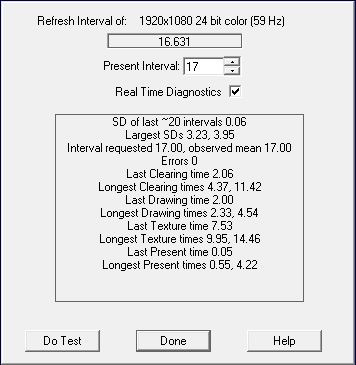TimeDX Help.
FreeSync Test.

The FreeSync test is designed to see if the
your adaptive sync setup (be it AMD FreeSync or NVidia G-Sync) is working before
using it in DMDX. Both AMD and NVidia
make displays and video cards that only send data to the display when it's
ready, they don't do it all the time thus allowing display presentation
intervals of almost any duration longer than the monitor's native (and therefore
maximum) refresh rate. This test functions in one of two ways, one
similar to the Retrace Rate test that presents
the test name and the interval it's been
asked to run at along with and alternating set of >< and <> brackets. If
the test is functioning then you should see undisturbed superimposed angle
brackets, if not it will flicker occasionally as the presenting rate slips in
and out of phase with the native refresh rate. If you have a kilohertz
camera you should be able to time the alternations of the angle bracket display
and see your requested display interval. In my testing on a non-FreeSync
system the one time I was
able to get a smooth angle bracket display was when I requested a interval less
than the native interval and here the Error count in the results quite large (as
opposed to it's usual value of zero in almost all other testing to date).
It should be noted that this test isn't designed to run at the native retrace
rate or faster as FreeSync is only going to run at rates lower than the native
panel retresh rate (ie, at intervals greater than the native panel interval
reported in the dialog).
Alternatively when the Real TIme Diagnostics check box is checked the test will
generate a new diagnostic display. Unfortunately because this information
is generated on the fly and texture preparation times can exceed a single
retrace interval the preparation is split up over three intervals (first one
clears the previous display's resrouces, the second draws them and the third
prepares the textures). The diagnostic
information includes the observed interval SD (because even a non GSync display is probably
going to average at the requested interval but it's SD should be the thing
giving away the non GSync functioning although this turns out to be a pretty
subtle sort of thing so the primary non-diagnostic mode of this test is probably
the most useful one). Additionally the Present() blocking times are
displayed as a
functioning GSync system should have close to 0 ms as long as the interval is
longer than the native retrace interval. If you see an observed interval
SD larger than a few milliseconds or Present() blocking times anywhere near the
native refresh interval you're either asking for a display rate that's
greater than your monitor allows or you don't actually have a FreeSync capable
setup...
The FreeSync test first runs the Retrace Interval test to
determine the native panel retrace interval and displays it. This will be
absolute minimum time you can expect to display something for. For
instance on the test 144 Hz panel this is 6.96 milliseconds and even if you use
a 100 Hz display mode this value will still be 6.96 milliseconds instead of the
usual 10 or so that one would expect to see. At least is it is on the GSync system
tested, FreeSync may behave differently.
The GSync and FreeSync panels also have a maximum refresh
interval and if you don't display something another retrace will be generated
(either in hardware for Gsync or software for FreeSync). When you request a
presentation interval that's at this interval or a few milliseconds longer than
it you should start seeing the angle bracket display flicker or the SD of the observed interval go up and Present()
blocking times may well go up too.
This test uses the most recent screen mode selected in the Video Modes test.
The 'R' key resets all values.
The 'A' key during Real Time Diagnostic display alternatively displays clearing, drawing, and
texture time information. The second alternative display generates all the
data every cyle and presents the correspondingly larger textures but future
machines are likely to be able to handle this test even if current systems are a
little taxed by it.
TimeDX Index.
